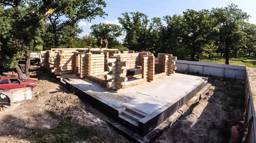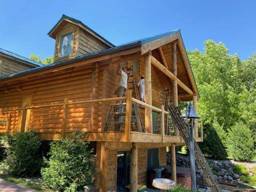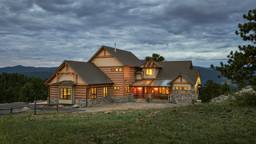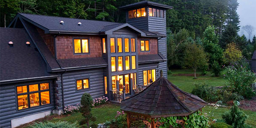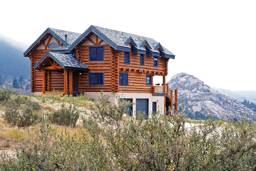Photo courtesy of True North Log Homes You’ve got your design finalized and you’re chomping at the bit to build. But it’s not spring. You’re outside of the construction sweet spot. Will the weather cooperate? Should you start or wait?
 A winter build is not off limits. The key is to anticipate any weather-related issues and then plan and budget for them.
A winter build is not off limits. The key is to anticipate any weather-related issues and then plan and budget for them.
Anticipating and preparing for weather-related issues isn’t limited to building in the wintertime. Because it takes months to build a home, inclement weather and its effect on your construction timeline and budget can hit anytime of year. Here are five things to consider so you can protect your house and your wallet when building a log home in bad weather.
Discuss scheduling concerns with your builder.
Be up front with your builder or general contractor and ask what sort of contingencies he or she has in place to handle weather-related delays. For example, mud on a job site can bog down heavy equipment and freezing temperatures affect concrete’s curing time.
Heavy rain or snow can make it impossible to do outdoor work. If these kinds of conditions continue for extended periods of time, they can really take a bite out of your schedule. Make sure your builder has a plan to keep construction on track if the weather goes off the rails.
Be smart about when you start.
Building in the off season can save you money, but you have to be cautious. Since this is often not a financially lucrative time for subcontractors, some may be eager to take on the work, even if it’s not advisable to do so.
For example, many log home sealants are sensitive to freezing temperatures or excessive moisture and applying them in the wrong conditions may reduce or destroy their effectiveness. Foundations, too, are tough to start in the winter. It’s generally not a good idea to dig a foundation until you’re ready build it, cap it off with a subfloor and backfill it.
But since concrete is sensitive to cold and heat, a poured foundation may need to wait. Ideally, your home should have a finished roof and all the exterior openings sealed before the first snow flies. If that’s not going to happen, use heavy gauge plastic to seal against short spells of foul weather.
If you have concerns about building your log home in bad weather but your builder wants to forge ahead, make sure he or she takes responsibility for the outcome, good or bad, and get it in writing.
Beware of budget busters.
Anything that upsets your construction timeline could impact your budget. A construction loan is based on “draw schedules” — payments made when key construction milestones are achieved. Unexpected expenses caused by weather-related repairs or delays typically aren’t part of a construction contract and could cost extra.
And like a traditional mortgage, construction loans come with an interest rate. According to Tom Coronato, a construction loan specialist with Citizens Bank, the current rate is about 4 percent (at the time of publication). If the project runs beyond the terms of the loan, interest is accrued daily based on your outstanding balance.
“Depending on your bank, there may be fees to re-qualify for your loan if it’s pushed out too far, and, if your rate was not locked in, that could cost you even more,” he says. Extending your building timetable could cost you thousands that you didn’t plan for. Keep your builder on task to finish on time.
Make allowances.
One of the best ways to deal with unexpected weather-related costs is to allocate a construction allowance. Within the total project cost, some items may be entered as an allowance rather than as a fixed price. This means you’ll always know how much money you’ve spent, and as long as costs stay within the allowance, you won’t be charged extra.
If you go this route, make sure the allowances are realistic. To plan properly, get independent bids from subcontractors. If they are substantially higher than what your builder is projecting, ask him or her to adjust the provided price or be prepared to cover any overages.
Protect your investment.
Lumber and logs can be covered with a secured tarp if necessary, but if you are buying a complete log home package, your manufacturer might be able to stagger deliveries, shipping logs and beams first, then windows, doors, roofing and trim later. Regardless of whether or not your materials can arrive in stages, your builder should have a storage plan that protects fragile and costly items.
A portable onsite storage shed should take care of that. Some materials, such as stains and sealants, should be kept in a conditioned space where the temperature is moderate and constant. If these precautions aren’t possible, ask your builder to either delay delivery of materials that can’t be protected properly or accept responsibility for them should something go wrong. And make sure your construction agreement spells out who is responsible for protecting the materials from onsite damage or theft.
Don’t let any of this discourage you from getting started on your log home dream ASAP. Weather is part of construction and can hit at any time of year — not just winter. Following your builder’s lead and preparing for the unexpected will help ensure that you can handle anything Mother Nature throws at you.
It’s important to choose the right builder. Learn more here!




